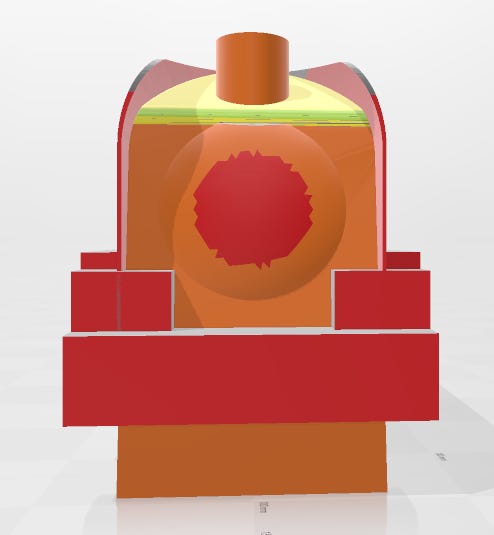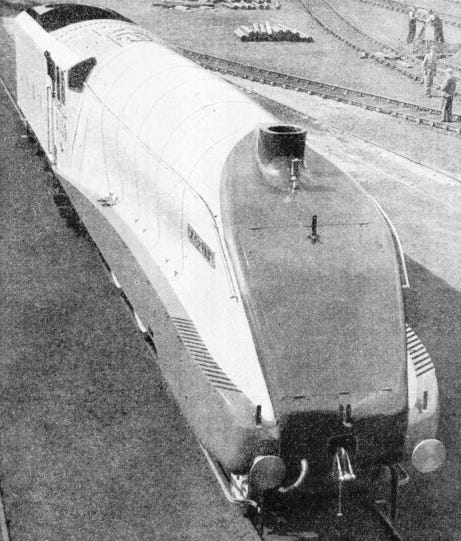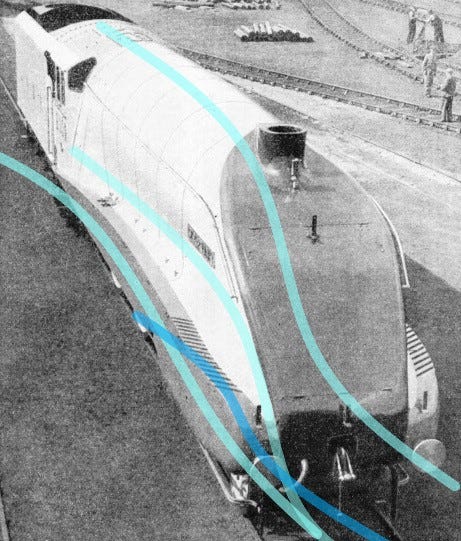Warning, this includes Conjecture, relies on a single source and is contradictory in nature.
For those Unfamiliar with Railway Wonders of the World, it was a weekly Engineering Magazine that was run by the Associated Press between 1935 and 1936, with it’s main editor being Clarence Winchester.
Now, Clarence had a Lot of Magazines at this point. Associated Press had him editing 18 different magazines at different points, many at the same time. But his Primary focus was Aeroplanes. Trains were not his Forte.
How do you get Content for an industry-specialist magazine in 1935. Same as today; Send letters to the right people, and see if they write back, edit appropriately.
In effect, Railway Wonders was the Propaganda book for the industry. Anonymously written articles would sing the praises of whichever department wanted to write. Occasionally, there would be sections written by Cecil Allen. An LNER engineer who also wrote British Locomotive Practice and Performance, Edited Trains Illustrated, and wrote several books, Particularly about Atlantics and Streamlined Trains.
1935 was an interesting year for Britain’s Railways, it was the year where much of steam locomotive development, in many people’s opinions, peaked.
Now, if you crawl through the extended library of the RWotW, You will find a certain theme within the offerings of the LNER. After an initial history piece, the engineering papers are as follows;
Locomotive Valve Gears; Part 1, 2 and 3.
The Booster Bogie.
Cock O' The North (Part 1, 2 and 3).
Development of the Locomotive Fire-Box.
Solving the Smoke Problem.
The Silver Jubilee.
Testing a Locomotive.
In all of these, we see drawings provided by the CME's department, LNER. Indeed, the Magazine thanks them for their contributions to the Magazine by writing articles.
The writing style is similar across most of these contributions, which would Imply a concurrent writer. And one with specific interests in certain topics, and one minded to write about interesting and informative engineering information. They’re well written and explain principles in locomotive design and their applications. They have been written, initially, by someone with a thorough understanding of what they are talking about, having invested time in to every detail, then summarised it for publishing.
Unfortunately, beyond this, and notes thanking the CME’s department, it is Unknown who wrote these articles in 1935. But some could look at the subjects involved and take an Educated Guess.
A Small Diversion.
Streamlining is the simplification or alteration of a designed object to make it pass easier through a fluid or gas. Imagine an upturned boat.
It’s also a really stupid term in Engineering, because it’s very broad and poorly defined, but at it’s core, if a design cuts through the air easier, it is more Streamlined.
Streamlining is a property which stems from the designer’s intent and the ultimate result in medium. Just because something is stylised, or shaped, does not mean it is Streamlined.
Wind-tunnel design is putting an object in a wind-tunnel and blowing an indicator over it to see how the air flows over the design. This is most easily Used in Streamlining, but it may be used for other things, such as flow management, where the flow of air or water may be used to a certain result.
The first vehicle used on Britain’s Railways to feature a design where the vehicle was shaped and formed with the idea to reduce drag, Effective streamlining that used a form of wind-tunnel design, was Webb’s LNWR Railcar of 1911, built by Daimler and using designs for Zeppelin fuselages to make an oblong railcar with rounded end windows that the air flowed around, and the Concept of airflow and Streamlining have been observed since the dawn of civilization. It was by no means new in 1935. Yes, Engineers would have been Aware of it, But it is not the be-all-and-end-all we make it out to be.
Sir Nigel Gresley was the Chief Mechanical Engineer for the LNER in 1935. He’s an interesting figure in Engineering, and in Railway History, with his most notable accolade is seen in the LNER A4, a Super-Pacific with a streamlined casing that optimised it’s speed, It runs with the Coronation, the first fully streamlined express train on the British mainline.
The conjecture comes that, in a series of articles from the LNER’s CME department, there are no reference to Streamlining, but instead, two articles relating to controlling Smoke and airflow to improve visibility, and improving operation and reliability in engineering. It could be Implied that the LNER didn’t want to share secrets, but on the other hand; Gresley did not build Race-horses. He built Work-horses, who could sprint. Engines were not built on conjecture, but sound principles and research. The A4’s are the culmination of a career’s research in to different engineering principles. The A4’s distinct look was not just streamlining, but at least 6 years of research in to air flow and the Smoke Problem. Not necessarily Going Faster.
Starting from the W1, in 1939. Except W1 is not streamlined. Nor is P2.
Just look at Hush Hush.
The high herringbone spine is because of the Boiler design, Which is designed by Yarrow, not Gresley. Gresley builds the engine around the boiler, using an elongated A3 chassis, and gives it effectively the same cladding as every other engine, factored for the unique boiler profile, but has to deal with Smoke because the Boiler is already seated at the top of the loading gauge, so there is little clearance for the traditional tall chimneys. This leads to the altered front end.
In terms of Streamlining, Head on, the lower 50% of the locomotive’s front section is vertical, and presents a greater wind Resistance than the average locomotive. What shaping is done is to compensate for the big Compound’s weak exhaust combined with a very short chimney, So the air over the upper half of the front is channelled in to a V which pushes the smoke up by creating a cushion of air over the boiler, which itself forms Compression and drag to do so.
This is Aerodynamics but it is not Streamlining. For the lower half of the locomotive, no effort is made to decrease air resistance and the design features several air-traps.
Which makes sense. Up to that point, most Streamlining effect kicks in past the 60mph mark, but the W1 was not supposed to be Faster than an A1, but More Efficient.
Gresley does take his model of W1 to a wind-tunnel and tests it, but it is Highlighted that this is to solve the Smoke problem. In the article, Solving the Smoke problem. The lower half of the boiler does not matter because the W1 would spend most of it’s time with a big box over the front end, for testing.
It is never used specifically for a speed run, and aside for showing generally comparable operation to an A1, it never Excelled.
The W1 was not Streamlined, and I’m not aware of the LNER making that claim, either.
But, the nose end does feed in to the P2, too. And Cock O’ The North… Also is not intended for speed.
The P2 was built for the East Coast Main Line between Edinburgh and Aberdeen. It was not Intended to go faster than an A3, It was not Intended to be a more Powerful A3, but it was designed to take an express train an A3 could take up the ECML comfortably, on the last sections of line.
Edinburgh to Aberdeen has steep gradients, and often, stations or curves before them, which forces slow speeds before a hill. This means that an Express has to take a standing, or near-standing start on a hill. This means there is a demand for Power and Adhesion. Normally, this would require a banker but Banking means more spare engines and train staff and slower time-tables. The P2 is intended to be an A3, designed for this challenging situation. Speed is not a factor.
It should be Unsurprising that this is then complimented by the U1, the LNER’s largest Tank Engine*; One is the Express Passenger equivalent of the Other. The P2 is not intended to get up to the speeds where the Streamlining effect does much beyond, perhaps, marginal percentage increases.
And again, if we look at the front of the P2; It’s Square. There is an Air-trap at the front, increasing drag.

There is Streamlining over the top of the boiler to reduce drag from the Dome, which produces eddies and currents which suck air down. It can be called Streamlining, certainly, but it’s only along the top of the locomotive, and… again, this is explained as being specifically for Smoke, not Speed.
So they are, at best, Partially Streamlined.
They do contribute features to the A4’s streamlining, but Streamlining is not a primary feature of the styling found on the W1 or P2. Instead, There is a detailed article explaining why they are Not streamlined, when compared to the GWR’s equally semi-streamlined King and Castles.
So… Cecil Allen?
The golden boy of 1930’s media reporting on locomotive performance, Cecil Allen literally Wrote the Book on Streamlining, and Pacific classes. And he is a consulting author and editor for the Railway Wonders of the World.
Two articles we can definitively put down to being his are Locomotive Speed Records, Speed Trains of Britain, Speed Trains of Europe, Speed Trains of North America, and the Silver Jubilee. I would add, thanks to his writing style, a most likely to be added to Experimental Locomotives, Test Run on Cock O’ The North, And he Edited Cock O’ The North. He writes very referentially to his other articles, making an interconnected web which Winchester does not.
Cecil Allen was an LNER Engineer in the Track Department, he measured and checked the rail-heads, and had little or nothing to do with Locomotive design, his contributions to British Locomotive Practice and Performance came from the fact he would often have to ride between depots and work sites, and would often choose to travel on crack expresses to do so. While I do not say he was inexperienced, he was certainly an Enthusiast who focussed on Speed and Power, and who uses his editorship to get access to prestigious speed runs. Or so it can be Extruded.
It is Cecil Allen who first makes the Claim, after the unveiling of the Coronation, that the P2 and W1 are Streamlined, because the three engines share a similar frontal profile and air-smoothed top section, Despite having records from LNER CME’s Office explaining that it’s more complicated than that.
Without undermining Gresley, Do we take Allen’s statement too seriously?
When considering the design of the A4, we do enjoy talking about Speed, to the point that the locomotive’s Reliability is considered almost a surprise.
But Silver Link did more than 5,300 miles with no major testing, less than a month old, it ran daily trains (Excluding Weekends) at a high rate of speed and a high rate of Accuracy, with marginal differences in the punishing timetable day-to-day, and when it was relieved by Quicksilver, And there were no notable flaws in the almost untested Prototype. The A4s are incredible examples of mechanical engineering in Steam locomotives. And the Streamlining is not just Streamlining. It’s a complicated series of different efficiency measures.
Just look at Silver Link.
Or look at it again with Doodles.
The A4’s form is genius, but it’s Not just Streamlining. The top features, yes, the air cushion design for the smoke, without the fins to channel the air. This is the first time the air is allowed to push across the top of the design, rather than being channelled up the back of the Chimney, as seen in W1 and P2.
The bottom of the streamlining hems in slightly at the bottom front, reducing air flow over the front and moving more to the sides, which is then moved up, creating an Up draught over the cab which sustains that same pillow of air, pushing smoke away from the line of sight.
I am told that the Valences are Bullied, But the taper edge changing from a rounded profile to an extrusion on the running board pushes air running along the side, away from the flat sides of the cab, giving some smoother air as it vortices, reducing steam from the cylinders being caught in the updraft and blowing across the view, but instead either being torn up on the Zephyr, or blown Sideways and Down, Away from view.
And the vents.
We don’t talk about the Valence Vents, over the Cylinders, but we probably should.
Because Streamlining is bad. The Cylinders on an outside-cylinder loco are air-cooled, and enclosing them in a box caused overheating for the GWR’s King, and possibly (I have no evidence of this, but can see where the issue is,) The P2.
The vents force cool air down in to a blank area infront of the cylinders and allows them to cool more efficiently without reducing the benefits or efficiency of the streamlining. The A4s which don’t get Valences also don’t get Vents.
The A4 is not a master of Speed, It’s not just an A3 in a Streamlined box, it’s a testament to data analytics by multiple engineers at multiple companies contributing to Gresley’s understanding, to make the best All Around Steam locomotive. One which achieves High efficiency, High performance and a low fuel economy. The A4 is not just a knife cutting through air, but it is using the air around it to make it more efficient, and give the Drivers ideal conditions.
And that is my point. The A4s are not Queens of Speed. They are not Thoroughbreds, They are Maids of all Work. And they prove it, time and time again. In the 1930’s, 1940’s, 1950’s and 1960’s, on heavy passenger and Goods turns, the A4s don’t shirk, but take every job Like a Duck to Water.
I’d take a guess and say that might be the real reason they’re named after Birds, not Racehorses like the A3’s. They are Fast in flight but can slow down and do other things, are more adaptable, and understated. Who can say it isn’t an elaborate in-joke? It’s as good as any other.
But the person who has Written all about them, and despite having access to resources to the contrary, repeatedly focussed on Speed, was Cecil Allen. And the person who’s line is most oft repeated, is Cecil Allen’s. And he doesn’t entirely hold a merit for being so highly regarded, because he’s quite often Wrong, and his more flowery prose overlaps fact and opinion with ease.
In looking at a work of art, we do like to look at people’s Interpretation of art, but at the same time, we also analyse construction method, artist’s intent, etc. And we’ve let the A4’s become Mallard. A lot of the Nuance goes out of the window. It’s hard to argue with, but the Speed and Power angle throws out the real work of art. The Analytic Spreadsheet. Efficiency, Cost Effectiveness. What the A4’s were Built for. What the P2 was Built for. What the W1 was Built For. Allen not only side-stepped the real magnificence of the A4s, but by proxy, created narratives which muddy the water over the P2 and W1, by focussing on Speed and Streamlining.
Which leads me to my source.
Railway Wonders of the World.
For the Most Part. It is a petty sideline project by the Associated Press, and it is visibly used and abused as a Propaganda booklet by the Big Four and London Transport. The Editor for the most part did not care about Railways. (The Southern slipping in that the King Arthur Class is the Most Powerful Engine in Britain in 1935. Despite it not even being the most powerful engine in it’s wheel group, being a very good example.)
Is it the most reliable source? No.
Should it be taken with a liberal pinch of Salt, Yes.
Did it have articles directly provided by the LNER CME’s Department that seemed to follow Gresley’s primary interests that he follows across that period, and details design decisions used on the P2 and culminating in the A4? Yes.
Can we confirm they were written by Gresley Himself? No. We will never know. We Barely know what Allen interfered with. Allen’s textbook fingerprints can be found dotted through several articles, with some sections saying It’s not streamlining, and others saying It’s Streamlining.
I Strongly Suspect that Cecil Allen was an unreliable Narrator who’s core statements and opinions have pushed historical opinions on a certain track, which may undermine how we look at certain locomotives against their original design and intent.
*No matter how you attempt to classify it, Leviathan makes strange bed-fellows. If it’s a Tender engine, it has no tender. If it is a Tank engine, Which makes sense as it has a forward water tank over the front chassis, then it is the strangest, and if it is grouped as an Articulated, then it should be joined by Gresley’s S1/2 and S1/3, and C9, as Mallets.



